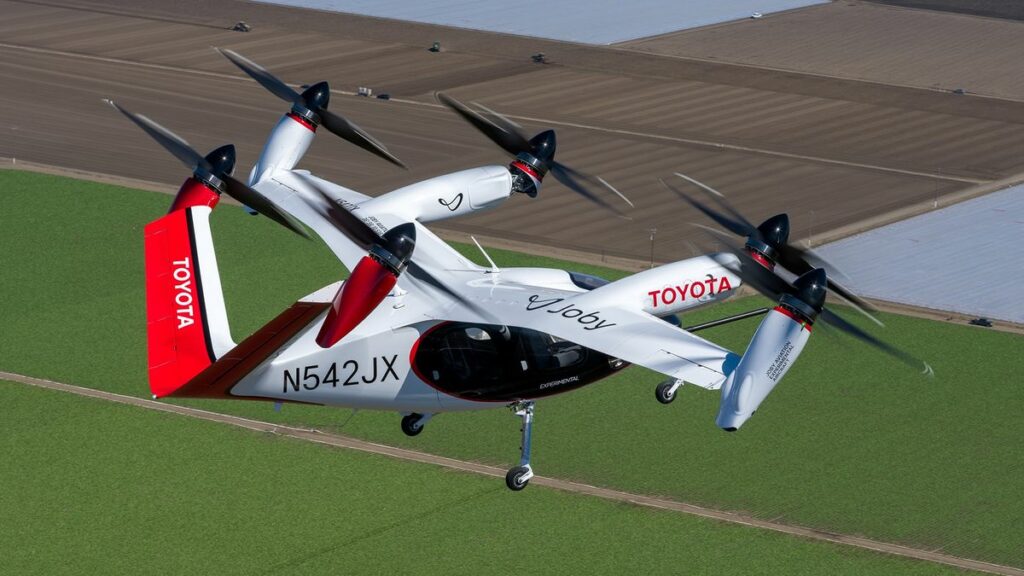Toyota invests $500 million in Joby Aviation to accelerate the development of electric vertical take-off and landing (eVTOL) air taxis, advancing the future of air mobility.
Introduction: Toyota’s Bold Move into Air Mobility
Toyota has taken another significant step in its journey toward air mobility by investing an additional $500 million in Joby Aviation. This investment follows Toyota’s initial $394 million injection in 2020, further strengthening the partnership between the Japanese car giant and the pioneering eVTOL company. Together, the two companies aim to speed up the development and certification of electric vertical take-off and landing (eVTOL) craft, realizing their shared vision of a future where air taxis become an integral part of urban transportation.
Joby Aviation, founded in 2009, has been at the forefront of eVTOL innovation and air taxi development, and with Toyota’s continued support, the company is well on its way to achieving commercial production.
A Partnership to Advance Air Mobility
Toyota’s investment in Joby Aviation is more than just a financial commitment. The partnership is rooted in collaboration, with Toyota bringing its vast experience in process planning, manufacturing, and design to the table. Engineers from both companies have been working side by side at Joby’s California facility, focusing on perfecting production methods for commercial electric air taxis.
By leveraging the Toyota Production System, a renowned methodology in the automotive industry, the two companies are tackling the complexities of large-scale production for this futuristic technology. While Toyota helps with production efficiency, Joby remains focused on achieving certification for its eVTOL craft, a crucial step in getting these air taxis into the skies.
Joby Aviation’s Progress Toward Certification
One of the most significant hurdles in the development of eVTOL technology is achieving regulatory approval. Joby Aviation is making steady progress toward this goal, with the company nearing the completion of the fourth stage in a five-stage type certification process. This certification, governed by the Federal Aviation Administration (FAA), is essential for Joby to move forward with commercial production.
The FAA finalized the airworthiness criteria for Joby’s aircraft earlier this year, allowing the company to accelerate its efforts to meet regulatory requirements. While the FAA regulates civil aviation in the United States, other countries, such as China, have their own sets of regulations, which may present additional challenges—or opportunities—for companies seeking to operate globally.
The Rise of eVTOL Craft: A New Era in Transportation
The rapid rise of electric vertical take-off and landing (eVTOL) technology has moved beyond science fiction and into reality, with numerous companies around the world developing air taxi solutions. Hyundai Motor Group, for example, launched its Supernal business to develop eVTOL craft, while China’s XPeng HT Aero is making significant strides in the field.
Most companies, including Joby Aviation, envision a future where eVTOL craft operate like Uber-style ride-hailing services, enabling small groups of customers to travel short distances quickly and efficiently. These electric aircraft resemble large drones, with multiple rotors allowing for vertical takeoff and landing. In some cases, unmanned flights are also being considered for the future.
Supernal’s SA-2 electric aircraft is a prime example of the potential of eVTOL technology. Designed to carry up to four passengers, this craft can travel at speeds of up to 120 mph for distances ranging from 25 to 40 miles. Flying at an altitude of around 1,500 feet, the SA-2 is designed to beat traffic and congestion in urban areas, ferrying passengers from one ‘vertiport’ to another.
Global Developments and Challenges in eVTOL Adoption
The race to develop and deploy eVTOL craft is not limited to the U.S. Companies around the world are exploring how this technology can revolutionize urban transportation. A recent market report revealed that at least 1,044 eVTOL vertiports are currently being developed, with the potential to be operational by 2028. These vertiports will serve as hubs for eVTOL craft to take off and land, enabling seamless travel across busy cities.
However, regulatory challenges remain. While the FAA has established criteria for the certification of eVTOL craft, other countries have different rules and standards. China, for instance, may offer fewer regulatory restrictions, allowing companies more freedom to test and develop their technology. This could give Chinese eVTOL companies a competitive advantage in the global market.
Looking Ahead: The Future of Air Mobility
As Toyota deepens its partnership with Joby Aviation, the future of air mobility looks more promising than ever. With continued investment and collaboration, the two companies are making significant progress in the development and production of eVTOL air taxis. Once regulatory hurdles are cleared and production processes are optimized, eVTOL technology is poised to revolutionize urban transportation.
The potential benefits of eVTOL craft are immense. Not only could they significantly reduce travel times by flying over traffic, but they also have the potential to reduce carbon emissions by using electric power. As eVTOL technology evolves, it is expected to play a critical role in shaping the future of sustainable, efficient transportation.
Conclusion: Toyota and Joby Aviation’s Vision for Air Mobility
Toyota’s latest $500 million investment in Joby Aviation highlights the growing importance of eVTOL technology in the future of transportation. As air taxi research and development accelerates, with major players like Toyota and Joby leading the charge, the world may soon see electric air taxis becoming a reality in major cities.
With regulatory progress and the ongoing development of vertiports, eVTOL technology is closer than ever to transforming how we navigate urban environments. As Toyota and Joby continue to collaborate on production and certification, their shared vision of air mobility is rapidly taking shape—one that promises to change the way we think about transportation forever.
For more updates on the latest developments in air mobility, stay tuned to Retail Technology Review.







